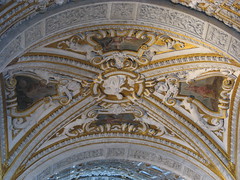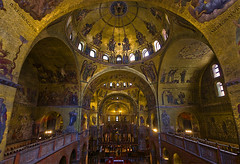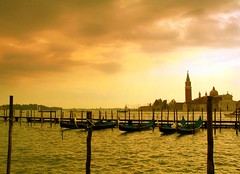Venice in three days
Da Venicewiki, il wiki di Venezia
What to see in Venice in three days
The visitor after, also for the first time, this magnificent experience, will be able to have some broad indications of the Venetian city from which, however, can not be ignored.
The starting point of each excursion through the streets and fields Venetians must be St. Mark's Square, the hub of Venetian power and its glory, with the St. Mark's Basilica, in which the walls 828 is kept the Body of St. Mark and the seat of ecclesiastical power, the Doges' Palace, whose current form in which it met the Maggior Consiglio, the assembly of noble emblem of political power and the judiciary, Biblioteca Nazionale Marciana founded in 1520, built by Jacopo Sansovino, jealous guardian of thousands of ancient books and priceless manuscripts and then the culture in these places is the depository .

All the rooms are beautifully adorned with Venetian paintings of the greatest artists and not, Tiziano, Tintoretto, Jacopo Palma il Giovane, Giovanni Bellini, Vittore Carpaccio, Paolo Veronese, the stucco of Alessandro Vittoria, the sculptures of Jacopo Sansovino ...
Even the Gran Caffè Quadri with the dining rooms on the first floor of the Old Magistrates offers a dip in the opulence of the city center doge, with large chandeliers Murano and sumptuous damask upholstery to the walls.
The first island is the Venice Cemetery, the island of St. Michael. The cemetery is monumental and the Venetians over the dead, even passion for many Venetians who wanted to be buried in this place.
Here lie distinguished international artists, including Ezra Pound (1972), Igor Stravinsky (1971), Sergei Diaghilev (1929), Joseph Brodsky (1996), Frederick William Rolfe, and of course the famous Venetian including the playwright Giacinto Gallina, the historian and scholar of Giulio Lorenzetti, Major aviation Pier Luigi i (1934), comedian Venetian Cesco Baseggio, the composer Luigi Nono (1990), the painters Virgilio Guidi, Emilio Vedova (2006) and Armando Pizzinato, and many other Venetian for love as the famous coach Helen Herrera (1997) and Ashley Clarke (1994), British ambassador in Italy and founder of The Venice in Peril Found.
No one is ever indifferent to the skill and dexterity of the masters, who produced, as always, magnificent objects, each one different from having their natural position at the Museum of Glass, in which are exposed pieces ranging from the Phoenicians to the Romans, from the Middle Ages to 700, until the pieces of famous masters such as Venini or Cendese, they have worked with renowned architects such as Carlo Scarpa.
Through the site you can Book a visit to a Murano Glass Factory going to the relevant page.
Murano also offers a dip in Romanesque art with the beautiful Basilica dei Santi Maria e Donato, with the apse crowned by round columns and Romanesque capitals in Istrian stone and red Verona marble. The floors are a unique mosaic opus sectile, prior to the year one thousand.
From the pier to the lighthouse you can climb on the vehicle that leads to Burano, the island of laces and colorful houses.
Not far from Burano is Torcello, Venice before Venice.
Third Day can be spent or to visit the many museums Venice choosing whether to visit a museum as important as the Gallerie dell'Accademia where you can find paintings Tiziano, Carpaccio, Paolo Veronese or Scuola Grande di San Rocco where most of the paintings are made by Tintoretto, or wander Calli and Callette, Campi and salizade trying to find the spirit that so impressed Lord Byron, Igor Stravinkji, Ezra Pound, Sergei Diaghilev who have loved this city so much that they wanted to be buried on the island of San Michele cemetery of the city.
An experience not to be missed is to try to know the Venice channels, if you book a typical Venetian boat that allow you to discover corners that are not covered on foot, even considering the Double viability of Venice, canals and roads that only in places intersect or are parallel, but often have two distinct path circumventing a hand.
Adventure appealing to people who like to deepen their knowledge.
You can also decide to row like a venetian gondolier along with a venetian rowing expert.
For more information see http://venicewiki.it or write to alvise@venicewiki.org.





